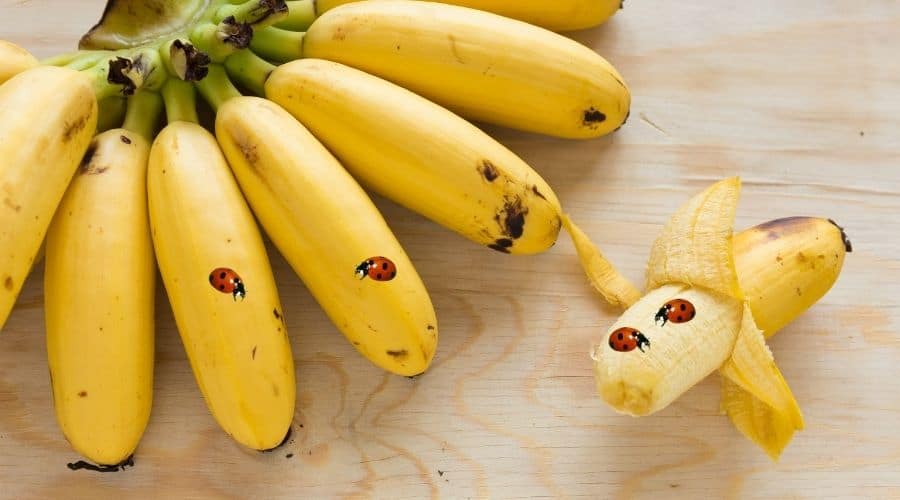Ladybugs aren’t ladies or bugs. As a member of the beetle family, these unusual dome-shaped creatures are not ‘true’ insects.
Also known as Ladybirds, Bishops, and many other names, a ladybug is an essential part of any garden since each one can eat an impressive five thousand aphids in a lifetime. That’s enough to save you a lot of plant damage. Can ladybugs eat bananas?
Ladybugs main source of food comes from aphids and soft-bodies insects, however the Epilachninae subfamily are herbivores and prefer leafy plants and sweet, moisture rich fruits like bananas. Ripe bananas have a pH of about 5, making them easier for a ladybugs digestive system to handle the sugars rather than high acidic fruits like oranges.
Table of Contents
Do Ladybugs Eat Bananas
Ladybugs do eat bananas, though the majority of their diet is soft-bodied small insects. Ladybugs love all sugary foods, not just fruits, so that you can feed them honey or even soft candies like taffy.
The sugars inside sweet foods are digestible to these small beneficial beetles. They can turn the sugars into energy, just like protein from bugs.
Acidic fruits like citrus aren’t good for ladybugs. Their digestive systems aren’t as capable of processing acids as they are with sugars.
Though bananas, apples, and other sugary fruits provide plenty of healthy energy, ladybugs will shy away from any fruits with harmful citric acid levels in them.
A ripe banana has a pH of around 5. There is a small amount of acid in them, but nothing approaching the levels of grapefruit, pineapple, or even a strawberry.
How Do Ladybugs Eat Bananas
A ladybug’s mouth can chew anything small enough for them to take a bite so long as it has a high moisture content.
While these tiny beetles can and do drink water, most of the water they need comes from the foods they eat.
Soft-bodied bugs like aphids and high water content fruits like banana, papaya, persimmon, and grapes also help the ladybug meet its hydration needs.
According to Infinite Spider, “They have maxillary palps for feeling and tasting (they look like antennae but are smaller and they are often clubbed), an upper labrum or lip, a lower labium, chewing mandibles (pinchy bits, often serrated), and grasping maxillae (bits for holding).”
Instead of teeth or the bony ridge that some lizards use, ladybugs chew with their mandibles. These mobile mouthparts grind down their food so they can swallow.
The mandibles may help scoop water into their mouths when they drink. Plus, they function as pincers to catch soft-bodied insects or tear off a piece of banana.
How Often Will Ladybugs Eat Bananas
Not all ladybugs eat bananas, but the Epilachninae subfamily are herbivores and prefer leafy plants and sweet, moisture-rich fruits.
Ladybugs are diurnal, so they sleep at night and eat mainly during the daytime hours. If you are raising your own ladybugs, it’s crucial to ensure they have sufficient food one to two times daily.
Feed ladybugs half a torn-up lettuce leaf, plus a small slice of banana. They shouldn’t need more than about a tablespoon unless you have a large enclosure.
Sadly, the directions on care and feeding for these insects rarely mention numbers, so you’ll have to eyeball it and make sure you add more fruit as needed.
It’s also a good idea to offer them a few drops of water mixed with honey to drink. Refresh the water as often as they drink it, or it evaporates.
According to Dirt Eat Clean, “The ladybug spends much of the day feeding… For the most part, the ladybug larvae eat pollen, mushrooms, and nectar to supplement their diet. When a ladybug is in the larval stage, it begins to feed on aphids.”
Will Bananas Harm Ladybugs
Bananas will not harm ladybugs. Even if you feed them far too much, they will be just fine.
Fortunately, these clever beetles are not prone to overeating, and they won’t get too much fruit or sugar regardless of what you place in their enclosure or area of the yard.
A ladybug stops eating when it’s not hungry. Additionally, they are surprisingly bright about population control.
Ladybugs won’t overbreed if you keep them in containers because they don’t like being overcrowded or fighting for food. In nature, they spread out except when they are gathered in huge groups, called aggregations for breeding.
Female ladybugs lay their eggs near food sources. Usually, this means aphids, but there are over five thousand kinds of ladybugs and around five hundred species in North America.
Since these include both the familiar red and black variety and many others, some lay eggs on fruit trees for the insects, but others expect to eat the fruit. This includes bananas.
Although their tiny mouths aren’t likely to help cut through thick skins like those on bananas, overripe fruit splits open.
Suppose they aren’t eating thinner skinned fruits, like grapes or blackberries. In that case, damage and over ripeness are the two most likely access points for these diminutive beetles to reach the sugary food naturally.
Helpful Tips To Know If Ladybugs Can Eat Bananas
In addition to other sugars and low acid fruits, ladybugs enjoy bananas. Herbivorous species of aphids and those who eat fungus especially enjoy a fruity treat, though most types can handle a little bit of banana.
Here are more helpful tips to know if ladybugs can eat bananas.
- Some people believe that ladybugs, like moths, eat wood and fabric. Fortunately, this is merely an old rumor and is not based on facts. A ladybug indoors will seek out surfaces where minuscule soft-bodied insects hide and eat them.
- In addition to bananas, taffy, and honey water, ladybugs are fond of chocolate. It’s better to feed them natural snacks. Nevertheless, if you plan to give them chocolate as a treat, make sure it’s from a reasonably pure source like a Hershey bar that is made of milk, sugar, and cocoa.
- Several species of ladybug larvae eat pollen and nectar to grow. Flowers are one of their natural habitats and this includes smaller fruit flowers like apple and peach blossoms, and their more unusual, larger cousin the banana flower.
- There is a species of aphid known as the banana aphid. A ladybug’s enjoyment of bananas probably comes from hunting these specific prey.
Final Thoughts
Ladybugs will happily eat non-acidic fruit like bananas. With over five thousand unique species of ladybugs on earth, many are omnivores, like the types found in most North American gardens.
However, some ladybug varieties are herbivores who dine primarily on leaves instead of the bugs who eat them.
Unfortunately, leaf-eating ladybugs are not beneficial to your garden, but since the most common species in the USA eat aphids, you probably don’t need to worry.
The usual red and black dome-shelled types you see will help destroy insects and make your garden healthier, so feel free to offer them a slice of a banana now and then to thank them.

